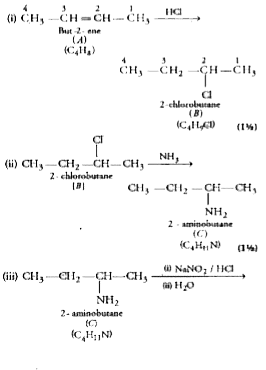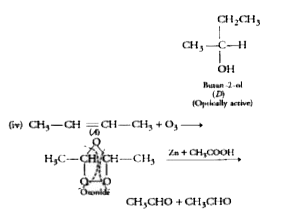A hydrocarbon A(C4H8) on reaction with HCl gives a compound 'B' (C4H9Cl) which on reaction with 1 mole of NH3 gives compound 'C'(C4H11N) . On reacting with NaN02 and HC1 followed by the'treatment with water, compound 'C yields an optically active alcohol, 'D'. Ozonolysis of 'A gives 2 moles of acetaldehyde. Identify compounds 'A to 'D'. Explain the reactions involved.Solution in Odia
Addition of HCl to compound CA. shows that compound .A. is alkene because compound .B. is:
C4H9Cl
(ii) Compound .B. reacts with NH3, to form amine .C..
C4H8HCl−−→C4H9ClBNH3−−→C4H11NC or C4H9NH2
(iii) .C gives diazonium salt with NaNO2/HCl, which yields an optically active alcohol. So, .C is an aliphatic amine.
(iv) .A. on ozonolysis produces 2 moles of CH3CHO.
So, .A. is CH3−CH=CH−CH3 (but-2-ene) (1)
Therefore, overall reaction sequence look like:


Topper's Solved these Questions
- ARYL DIAZONIUM SALTS BOOK - ARIHANT PUBLICATIONCHAPTER - ARYL DIAZONIUM SALTS EXERCISE - ODISHA BUREAU.S TEXTBOOK SOLUTIONS (MULTIPLE CHOICE TYPE QUESTIONS)
12 Videos
- ARYL DIAZONIUM SALTS BOOK - ARIHANT PUBLICATIONCHAPTER - ARYL DIAZONIUM SALTS EXERCISE - ODISHA BUREAU.S TEXTBOOK SOLUTIONS (VERY SHORT ANSWER TYPE QUESTIONS)
4 Videos
- ARYL DIAZONIUM SALTS BOOK - ARIHANT PUBLICATIONCHAPTER - ARYL DIAZONIUM SALTS EXERCISE - QUESTIONS FOR PRACTICE (SHORT ANSWER TYPE II QUESTIONS 3 MARK)
5 Videos
- AMINESBOOK - ARIHANT PUBLICATIONCHAPTER - AMINESEXERCISE - Chapter Practice (Long Answer Type Questions)
2 Videos
- CARBOXYLIC ACIDS BOOK - ARIHANT PUBLICATIONCHAPTER - CARBOXYLIC ACIDS EXERCISE - CHAPTER PRACTICE (LONG ANSWER TYPE QUESTIONS)
3 Videos
Similar Questions
The diazonium salts are the reaction products of the reaction of nitrous acid with
View SolutionWrite the structure of benzene diazonium chloride.
View SolutionAccomplish the following conversions. (i) Benzene to m-bromophenol
View SolutionWhat are amines and how they are classified? Give suitable examples along with their common and IUPAC names.
View SolutionConvert
(a) the benzoic acid to benzaldehyde
(b) the propanone to propane
View SolutionA hydrocarbon A(C_4H_8) on reaction with HCl gives a compound B(C_4H_9Cl) which on reaction with 1 mole of NH_3 gives a compound C(C_4H_(11)N) . On reacting with NaNO_2 and HCl followed by treatment with water, compound C yields an optically active alcohol,D. Ozonolysisi of A gives 2 moles of acetaldehyde. The structure of compound C is
View SolutionOptically active isomer (A) of (C5H9Cl) on treatment with one mole of H2 gives an optically inactive compound (B) compound (A) will be :
View SolutionA hydrocarbon 'A' (C_(4)H_(8)) on reaction HCl gives a compound 'B', (C_(4)H_(9)Cl) which on reaction with 1 mol of NH_(3) gives compounds 'C' (C_(4)H_(11)N) . On reacting with NaNO_(2) and HCl followed by treatment with water compound 'C' yields an optically active alcohol, 'D'. Ozonolysis of 'A' given 2mols of acetyldehyde. Identify compound 'A' to 'D'. Explain the reaction involved.
View SolutionAn organic compound (A), C_(8)H_(4)O_(3) in dry benzene in the presence of anhydrous AlCl_(3) gives ,compound (B). The compound (B) on treatement with PCl_(5) followed by reaction with H_(2)//Pd-BaSO_(4) gives compound C, which on reaction with hydrazine gives a cyclised compound (D) of formula C_(14)H_(10)N_(2) . Identify (A),(B),(C ) and (D). Explain the formation of (D) and (C ).
View SolutionAn organic compound A , C_(4)H_(4)O_(3) in dry benzene in the presence of anhydrous AlCl_3 gives compound B. the compound B on treatment with PCl_(5) , followed by reaction with H_(2)//Pd(BaSO_(4)) gives compound C, which one reaction with hydrazine gives a cyclised compound D (C_(10)H_(10)N_(2)) . identify A,B,C and D. Explain the formation of D from c.
View Solutionप्राथमिक ऐल्किल हैलाइड C4H9Br(a) ,ऐल्कोहॉलिक KOH से अभिक्रिया द्वारा यौगिक (b) देता है यौगिक 'b' HBr के साथ अभिक्रिया करके यौगिक 'c' देता है जो कि यौगिक 'a' का समावयवी है। जब यौगिक a की अभिक्रिया सोडियम धातु से होती है तो यौगिक 'd'C8H18 बनता है, जो n-ब्यूटिल ब्रोमाइड की सोडियम से अभिक्रिया द्वारा बने उत्पाद से भिन्न है। उत्पाद से भिन्न है। यौगिक 'a' का संरचना सूत्र दीजिए तथा सभी अभिक्रियाओं की समीकरण दीजिए।
View Solutionप्राथमिक ऐल्किल हैलाइड C4H9Br, (क ), एल्कोहलिक KOH में अभिक्रिया द्वारा यौगिक (ख) देता है । यौगिक 'ख' HBr के साथ अभिक्रिया से यौगिक 'ग' देता है जो कि यौगिक 'क' का समावयवी है। जब यौगिक 'क' की अभिक्रिया सोडियम धातु से होती है तो यौगिक 'घ' C8H18 बनता है जो कि n-ब्यूटिल ब्रोमाइड कि सोडियम से अभिक्रिया द्वारा बने उत्पाद से भिन है । यौगिक 'क' का सरंचना सूत्र दीजिए तथा सभी अभिक्रियाओं के समीकरण दीजिए।
View SolutionA hydrocarbon 'A', (C_(4)H_(8)) on reaction with HCl gives a compound 'B', (C_(4)H_(9)Cl) , which on reaction with 1 ol of NH_3 gives compound 'C', (C_(4)H_(11)N) . On racting with NaNO_(2) and HCl followed by treatment with water, compound 'C' yields an optically active alcohol, 'D'. Ozonolysis of 'A' gives 2 mols of acetaldehyde. identify compounds 'A' to 'D'. explain the reaction involved.
View SolutionCompound (A) with molecular formula C_(2)H_(4)O reduces Tollen's reagent. (A) on treatment with HCN gives compound (B). Compound (B) on hydrolysis with an acid gives compound ( C) with molecular formula C_(3)H_(6)O which is an optically active compound. Compound (A) on reduction with N_(2)H_(4)//C_(2)H_(5)ONa gives a hydrocarbon (D) of molecular formula C_(2)H_(6) . Identify (A), (B), ( C) and (D) and explain the reactions.
View Solutionप्राथमिक ऐल्किल हैलाइड C4H9Br(A), ऐल्कोहॉलिक KOH में अभिक्रिया द्वारा यौगिक (B) देता है | यौगिक (B) HBr के साथ अभिक्रिया से यौगिक (C) देता है जो कि यौगिक (A) का समावयवी है | जब यौगिक (A) की अभिक्रिया सोडियम धातु से होती है तो यौगिक (D) C8H18 बनता है, जो कि n-ब्यूटिल ब्रोमाइड की सोडियम से अभिक्रिया द्वारा बने उत्पाद से भिन्न है | यौगिक (A) का संरचना सूत्र दीजिए तथा सभी अभिक्रियाओं के समीकरण दीजिए |
View SolutionAn organic compound (A) C8H4O3 in dry benzene in the presence of anhydrous AlCl3 gives compound (B), the compound (B) on treatment with PCl5 followed by reaction with H2/Pd(BaSO4) gives compound ( C ) which on reaction with hdyrazine gives a cyclized compound (D) C14H10N2. Identify (A), (B), ( C ), and (D). Explain the formation of (D) from ( C ).
View Solution
